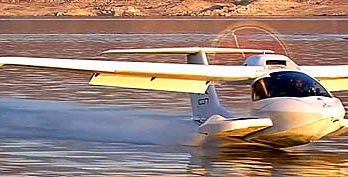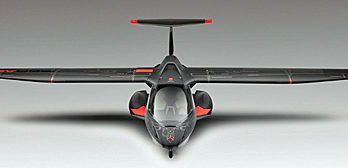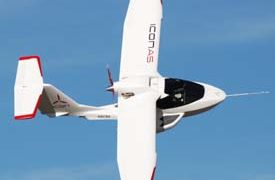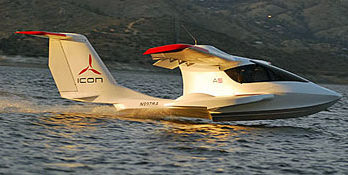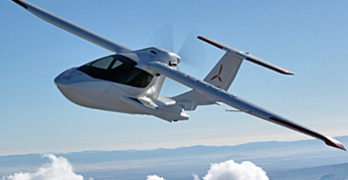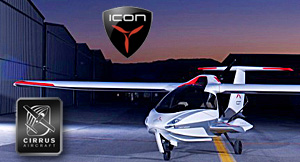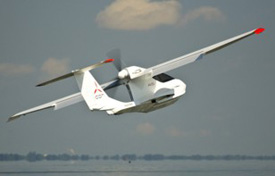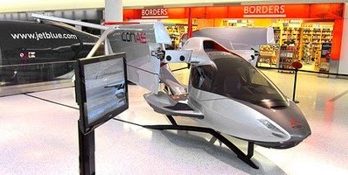One of the most celebrated of the Light-Sport Aircraft fleet is Icon Aircraft‘s A5 seaplane. The Southern California company has passed the benchmark set by Cessna after they first announced their Skycatcher to great fanfare back in 2007. Since Icon first emerged in 2005, the company has gone from one man with an idea to one of the largest players in the LSA space … yet they have yet to produce their first airplane. Some aviators have voiced concerns the company is a marketing juggernaut that raises money but builds nothing. To confront this perception and in preparation for their usual announcements at AirVenture — the only show where Icon chooses to present itself for the time being — Icon released photos and some details of their work to make production a reality. One of their earlier announcements related to engaging SR20 and SR22 manufacturer Cirrus Design to do component assembly.
Search Results for : Icon A5
Not finding exactly what you expected? Try our advanced search option.
Select a manufacturer to go straight to all our content about that manufacturer.
Select an aircraft model to go straight to all our content about that model.
X-Ray Views of Icon’s Amphibious LSA
If you traveled to Oshkosh for AirVenture 2013, you got to see a lot of airplanes and other aviation gear. EAA reported a very substantial crowd of more than 500,000 attended. As this might translate to 150-200,000 pilots, the big figure nonetheless means that more than 400,000 American pilots did not go to AirVenture. That majority of flying enthusiasts missed a lot but recently Icon Aircraft sent out news about their X-Ray View of their Light-Sport entry. This impressive display was shown in their big tent and many examined the details. If you missed AirVenture 2013, we’re happy to show you a little of what you missed.
Icon circulated photos of what the company informally terms its “three-dimensional CAD drawing” of the company’s A5 amphibious Light Sport Aircraft (LSA). “The full-scale 3D model employs automotive vinyl wrap technology,” explained Icon, “printed with an adapted projection of the Computer Aided Design (CAD) virtual model depicting the location and layout of key structures and systems of the aircraft, which provides an unprecedented level of technical detail about the production A5.” If you’ve been wondering what’s under the skin of the handsome LSA amphib, the special graphics were very helpful.
Icon Gets Its Weight Exemption
Important FAA-related message at end of this article.
Opening day at AirVenture Oshkosh 2013 and the very first announcement before exhibit spaces even opened was a press conference from Icon Aircraft. To a media-only group of perhaps 30 or 40 media personalities, CEO Kirk Hawkins began, “Is there anyone here who doesn’t know what this about?” No one responded; everyone knew what the rumor mill had begun spewing. Icon is in good company. Even premiere new product secret-keeper, Apple Inc., has trouble announcing something that no one expected. Yet a few comments from the top gun at Icon were of special interest. One other observation first: it was a media event, but if even a single FAA person was in attendance, they were under cover. No FAA shirts or badges could be spotted. Thus Icon made their announcement without any active FAA participation.
Icon received Grant of Exemption No. 10829 for a weight increase with FAA stating,”The combined features and SRA (Spin Resistant Airframe) incorporated into the Icon A5 design … are recognized by the FAA as significant safety enhancements.” FAA also referenced that the agency felt an exemption was “in the public’s interest.” Kirk Hawkins added that his engineers “put safety ahead of arbitrary weight limits” and forged ahead with enhancements to include a more crashworthy cockpit, the airframe parachute (about which they’d already talked but with which the weight increase became more possible), and of course, the wing cuffs, “a synthesis of several known ideas put together in a way that finally worked” to provide a Part 23-worthy stall resistant airframe.
Weight Increase for Icon … Yes or No?
Fact #1: EAA ArVenture Oshkosh is coming in mere days. Fact #2: In the world of politics (and for that matter in corporate communications), you announce good news to big crowds or at the beginning of the week and you bury bad news on a Friday afternoon when maybe no one is listening hoping they’ll forget before a new week begins. So, if FAA may finally respond to Icon Aircraft‘s request for a 250-pound weight increase for their A5 LSA seaplane, Oshkosh would be a great place for FAA to announce it. The million-dollar question: Will FAA do this? And, what would it mean if the agency did announce it? My journalist friend, Al Marsh, over at AOPA just published a blog on this subject titled, “Why Icon will get its LSA weight exemption.” If you have any problem finding Al’s article go to AOPA’s blog website and click the “Reporting Points” heading, then scroll down as needed.
Icon Aircraft Reports Being Fully Funded
First Icon Aircraft wowed aviation enthusiasts with its sleek and uniquely featured amphibious A5 LSA seaplane. Over the years the company reported collecting around 1,000 orders, a success story that even beats Cessna’s Skycatcher. However, several years passed and the company did not enter production, although they reported a deal with Cirrus Aircraft to handle some fabrication duties. Perhaps all that changed now. The Southern California company announced that it raised its fourth and final round of funding totaling over $60 million. They’ll use the funds to “complete production preparations, demonstrate regulatory compliance, [and] ramp up full-scale aircraft production.”
CEO and Founder of Icon Kirk Hawkins said, “For the first time in Icon’s history, the company’s future is no longer reliant on the whims of the capital markets, which have been highly unstable over the last five years.” He identified that the new financing effort was led by a “multibillion-dollar conglomerate” strategic investor from China.
LSA News Wrap — Rotax-Icon-Tecnam-More
Another busy week finished a very active August that has seen high readership… for which we sincerely thank you. Following are some brief news stories in the LSA space.
*** ROTAX “EMERGENCY AD?” Aviation media was all over the Rotax “Emergency AD” story, but is that entirely accurate? Aren’t LSA subject to manufacturer-issued SBs or Service Bulletins rather than Airworthiness Directives, which are normally issued by FAA for certified aircraft? Well, “yes,” said Rotax expert Phil Lockwood. He explained that the matter in question — some fuel lines that need to be replaced — was a result of a vendor change bringing some incorrect components. “Rotax issued a Service Bulletin last spring on this subject,” Phil added. The so-called “emergency AD” was triggered by an EASA issuance primarily for certified Rotax engines in Europe. Rotax BRP is a very careful company that is quick to correct problems and this was something of delayed reaction that again appears to show the certified world may not respond as quickly as the LSA sector.
Cirrus Returning to LSA? Well, Yes… for Icon
Icon Aircraft and Cirrus Aircraft announced a deal for the general aviation composite aircraft producer to build parts of the Icon A5 and the news introduced dates for the A5 to come to market.
*** Several years ago I traveled to Cirrus’ Duluth, Minnesota plant in the company of the Icon top leaders, including CEO Kirk Hawkins. In those days, Cirrus was seeking info to make decisions about their since-dropped LSA project called the SRS (photo). The Icon fellows were obviously impressed and the trip subsequently paid off.
*** “Cirrus has a global reputation for producing truly outstanding composite aircraft structures,” said Hawkins. “Their extensive experience, specifically in composite sandwich-production techniques, makes them an ideal production partner for Icon.” Cirrus has built more than 4,000 of its SR models. Returning the admiration, Cirrus CEO Dale Klapmeier said, “The Icon A5 is certainly the most innovative LSA on the market.” He added, “We believe that Light-Sport Aircraft and Sport Pilots are critically important to the growth and future of aviation.”
*** Like most airframe makers these days, Cirrus may not be using all its capacity.
Icon Back on the Radar Screen
The splash heard ’round the LSA world continues to send out ripples, though it’s been years now since startup LSA maker Icon Aircraft first announced, with considerable marketing fanfare, its amphibious light sport amphibious project, the A5. *** Now comes word today from the company that’s it’s just completed a “demanding regimen of spin-resistance test flights. This milestone will make the A5 the first production aircraft in history to be designed to and completely comply with the Federal Aviation Administration’s full-envelope Part 23 spin-resistance standards developed from NASA’s work on the topic.” *** The lengthy release (a PDF file) goes on to enumerate the general cost in lives and hardware to civilian flying from stall/spin accidents, and cites its intentions to “design the A5 to the more difficult to achieve but safer standard of ‘spin resistant,’” as opposed to spin recoverable. *** Icon also conformed its testing regimen to the FAA Part 23 standard for certified aircraft.
Icon’s Mission of Outreach
Icon’s Mission of Outreach
ICON Aircraft calls itself “a consumer
sport plane manufacturer.”
Kirk Hawkins, an
accomplished engineer, former
U.S. Air Force F-16 fighter pilot
and avid power sports enthusiast,
founded the company. After learning
of the Federal Aviation
Administration (FAA) major regulatory
changes in ’04 that created
the light sport aircraft category
and sport pilot license, Hawkins
conceived his enterprise in ’05
while attending Stanford
University Business School.
Since then, ICON Aircraft’s sole
purpose has been to bring the freedom,
fun, and adventure of flying
to all who have dreamed of flight,
whether they are existing pilots or
other recreation enthusiasts.
ICON Aircraft believes that consumer-
focused sport aircraft can
do for sport flying what personal
watercraft did for boating. “ICON
aircraft are not only designed to
deliver an amazing and safe flying
experience, but also to inspire us
the way great sports cars do,”
explains the company.
A venture-backed, early stage
company out of Silicon Valley,
ICON Aircraft based its operations
in Southern California,
which is a hotbed for aerospace
engineering, automotive design,
and power sports activities.
ICONographic Marketing
I thought I’d share a couple interesting videos recently posted on the Icon Aircraft website. There’s a multimedia gallery of high-profile, appealing eye candy, including YouTube videos chronicling various aspects of the ongoing test program for the company’s A5 amphibian S-LSA. *** Two I found particularly interesting: a stall sequence and a potpourri of recent flight test ops. *** First, the stall sequence shows the classic tufted airflow indicators taped to the wing to demonstrate inflight stall progression from the root outward. *** Watch the tufts near the root begin to wiggle and change direction first, demonstrating loss of lift. Then see the stall move outward from the root and along the trailing edge. To my eye, it seems like the middle of the wing completely stalls before the root. I’d like to know about the aerodynamic significance of that, and why the wing doesn’t stall more classically at the root first.
- « Previous Page
- 1
- 2
- 3
- 4
- 5
- 6
- …
- 16
- Next Page »


